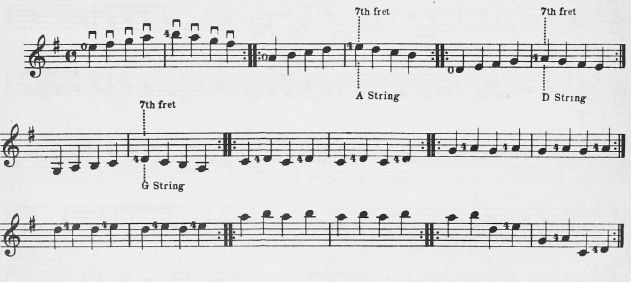Mandolin Self Instructor, online tutorial - Page 36
A simplified self learning system for the Mandolin with tuning instruction, song folio, chord diagrams, sheet music and PDF for printing. By ZARH MYRON BICKFORD
| Share page | Visit Us On FB |
|
The Use of the Fourth Finger
The use of this finger has so far been confined entirely to the E string-, but its use on all the
other strings is absolutely essential. While in certain places it might be a matter of choice wheth- er the seventh fret of a string or the next higher open string were used, there are many places where the use of the fourth finger is indispensible. For Example, it is practically impossible to execute properly in keys requiring flats without the continual use of the fourth finger. The high- er positions also require its use, as do rapid passages in which there would otherwise be an awk- ward movement of the pick. Its great importance cannot be over-estimated and the student who would be a well-rounded and efficient performer is cautioned never to avoid its use, either when it is marked in the music or when the passage could be made smoother or more effective by its use. One of the secrets of its control is to keep it always in a line with the other fingers and ready to drop at a moment's notice. The position of the hand should always be such that no change or shift has to be made when the little finger is used. Its motion, like the other fingers, must be entirely from the third joint, and while its shorter length will not allow the tip to touch the string so squarely as do the other fingers, it must be rounded as much as possible, so that the first and second joints do not "break" or bend inwards. In the following Exercises, (each two measures of which should be played not only twice, as the dots indicate, but several times), as the playing is transferred to the A, D and G strings, the outside edge of the hand is brought continually nearer the body so that when the G string is reached,the palm of the hand, at the base of the fingers,prac- tically touches the edge of the fingerboard. This is extremely important, and, if the thumb is held according to previous directions, will prove that the little finger is long enough to do anything that will be required of it. All fingers are to remain on the strings as long as possible. |
||
 |
||
|
Changing Fingers with the Up Stroke
Up to the present time, the taking of a new note has invariably come with the down stroke-an operation which requires less agility and exactness than when the note or finger changes with |
||